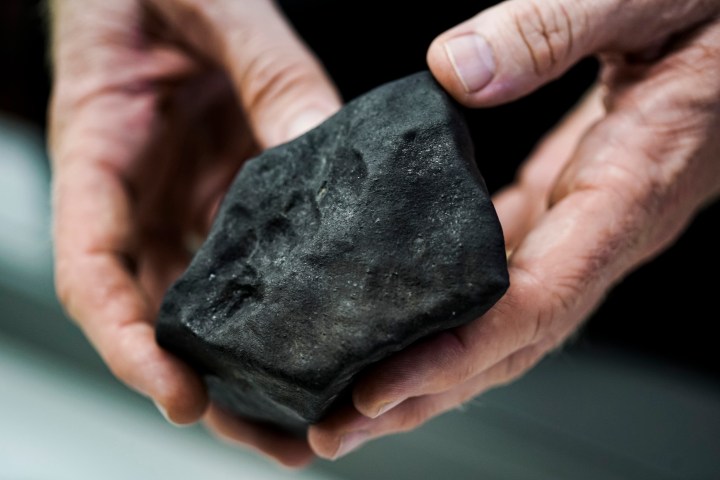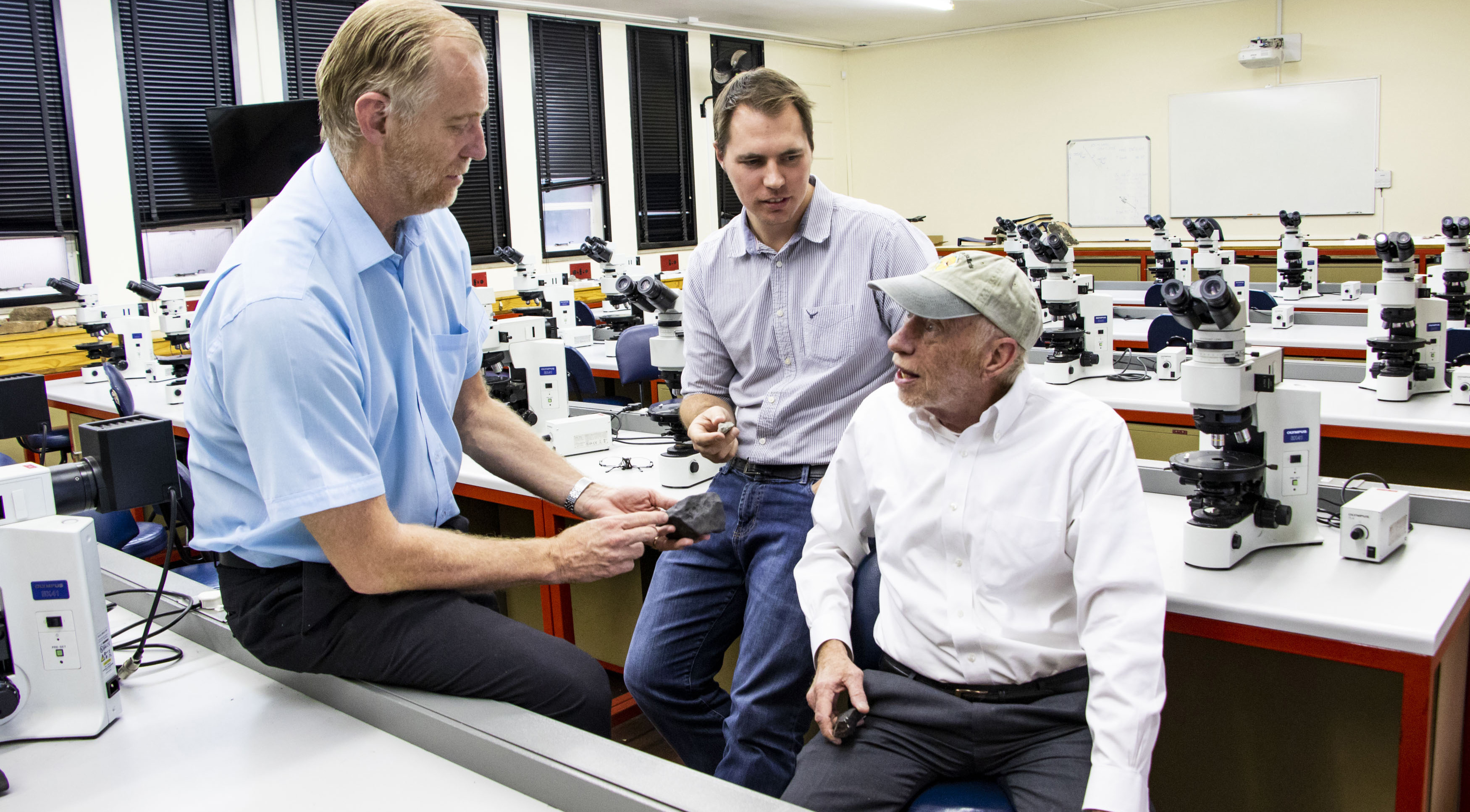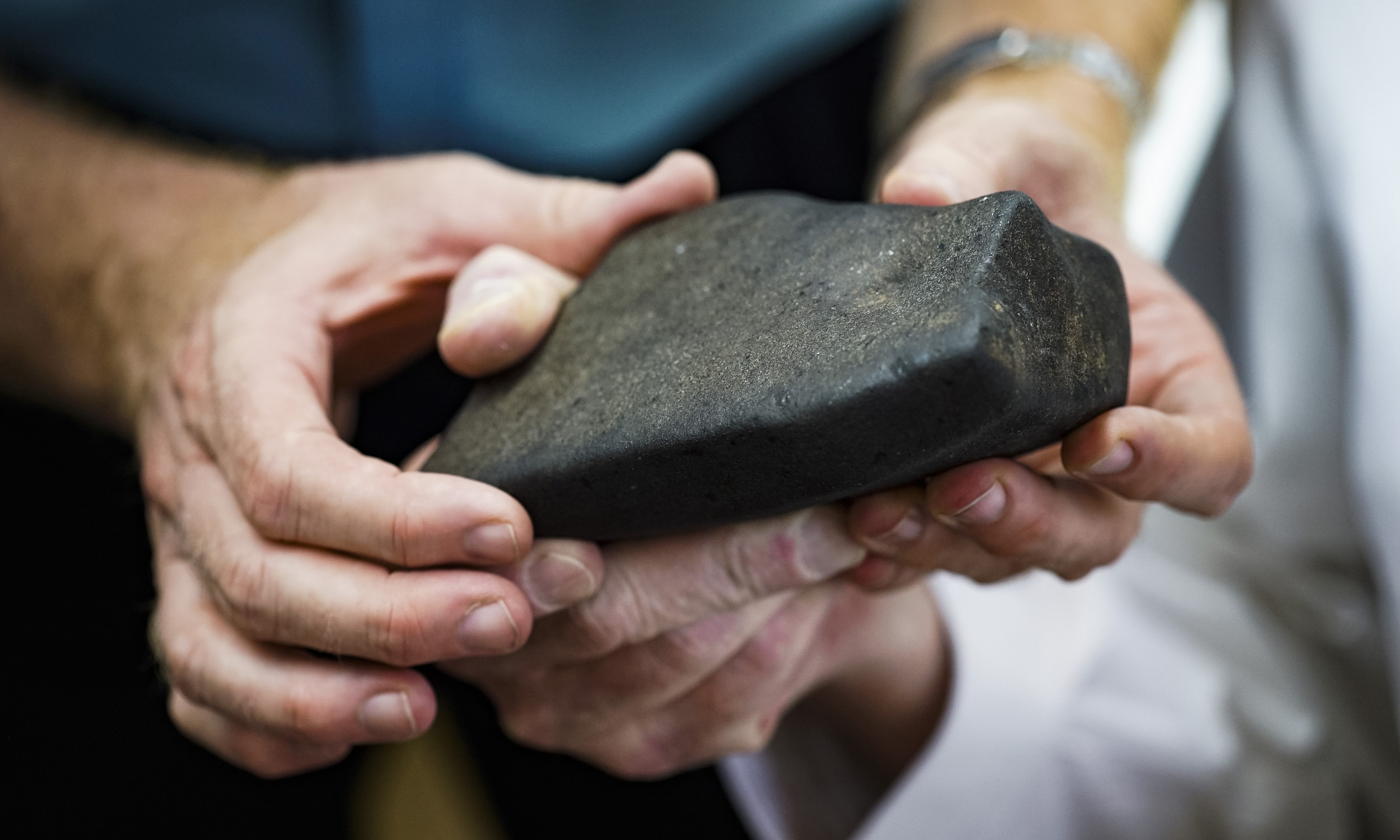In the night sky
Bright fireball and a fall to earth – the night Benenitra was ‘born’

If it wasn’t for Tim Marais, science might never have known about the strange object that blazed across the south-western Madagascan sky on the night of 27 July this year.
Tim Marais just happened to be in the remote Madagascan area, a couple of days after the object fell to earth around and on the town of Benenitra.
Learning that Marais was a geologist, the locals told him about the bright fireball, the explosion and the rain of rock fragments. Surprisingly, they told him that no one was hurt, and there was no damage to property.
The locals were even able to give him a couple of pieces of the rock.
When Marais got back to South Africa he handed the rocks to Professors Roger Gibson and Lewis Ashwal in the School of Geosciences at Wits University.

Professors Roger Gibson (left) and Lewis Ashwal (right) discussing their preliminary assessment of the Benenitra meteorite with Tim Marais. Photo: Wits University
And there the detective work began.
Their search would ultimately take them from dealing with the scientists who hunt nuclear explosions, to scrutinising the microscopic composition of those rocks, Marais had gathered.
What Gibson and Ashwal wanted to know and prove scientifically was that what the people of Benenitra saw that night was a meteorite.
By confirming that it was a meteorite, they could then have it classified and named. Once it is named, the discovery can be written up in a journal, and recorded for science.
First off the department’s senior technician Caiphas Majola took thin sections of the rock and examined it under a microscope.
He found that the rock fragments were indeed from a meteorite.
They belonged to a relatively common type of meteorite known as a chondrite.
“The next thing we needed to prove was, did it happen on that day,” says Gibson.
The scientists approached Dr Andry Ramanantsoa of the Laboratory of Seismology and Infrasound at the Institute and Observatory of Geophysics at the University of Antananarivo, Madagascar.
They wanted to know if there was any evidence of an explosion in the atmosphere at the time that the object appeared over Benenitra.
Through using infrasound data from the international Comprehensive Nuclear Test Ban Treaty Infrasound Station IS33 outside the capital, Ramanantsoa confirmed at there had been an “upper atmosphere energy release event” at 7.16 pm, local time.
The data also proved that the explosion occurred in the vicinity of Benenitra.
Next, they wanted to prove that this explosion left a seismic signature, so the team turned to Dr Andriamiranto (Ranto) Raveloson, a Post-doctoral Fellow and Technical Manager at the Africa Array Seismic Network.
He found that there had been a very faint seismic tremor at 7.17 pm, that night.
Just one more piece of the puzzle was needed to confirm that it was a meteorite.

Close-up of the meteorite fragment showing the fusion crust. Credit: Wits University
At the Laboratori Nazionali del Gran Sasso at the Istituto Nazionale di Fisica Nucleare in Italy, Dr Matthias Laubenstein measured the meteorite for rare cosmogenic nuclides.
These are created when an object is bombarded by high energy cosmic rays in space. Laubenstein discovered high levels of cosmogenic nuclides that suggested that the meteorite had entered the Earth’s atmosphere in the last couple of months.
It was case solved – the team had proven that the extra terrestrial object spotted over that remote corner of Madagascar was in fact a meteorite.
With this information, the team could now submit a request to the international Meteorological Society to officially name and register the meteorite.
They named it Benenitra.
“This meteorite is nothing spectacular, but what is exciting is that this is a meteorite fall, where people witnessed it and recovered it, and those are pretty rare,” says Ashwal. “Most meteorites are just found by a farmer or by someone walking around the bush,” he said.
Benenitra might be a common type of meteorite but chondrites do have their importance to science.
This meteorite is estimated to be about 4.5-billion years old, about the same age as the earth.
“Meteorites are commonly called The Poor Man’s Space Probe, because they deliver rocks from Outer Space to our door for free, where we can study the birth and history of other parts of our Solar System” says Gibson.
But the team would like to find out more about the meteorite. The plan is to perhaps get someone from the university of Antananarivo to travel to Benenitra, to collect some of the stories of the people who witnessed the meteorite come to earth.
“I would love to have their stories, we only have little snippets of information about what they did,” says Gibson. “For instance, some of the pieces that Tim saw were broken, yet the whole area is sand. We suspect because it is a gem mining district that they saw this fiery light in the sky and thought they contained gems, so they broke open some of the fragments.”
One day the hope is that the people of Benenitra will learn more about the phenomena that occurred over their town on 27 July.
“Ultimately the idea is that we would like to put it together as a story and if they still have some of the pieces, maybe they can put them on display or get them into the schools, because this is a piece of their history,” says Gibson. DM

















 Become an Insider
Become an Insider